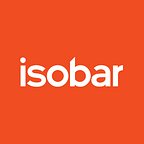Isobar Shanghai WeChat workshop explores design as the first step of putting your imagination into reality
As part of a series of events on Brand Commerce Consulting, Isobar Shanghai recently hosted a programme on Design Thinking for Dentsu Aegis Network clients and prospects. Following the sessions, Cloris Tong, Head of Client Services at Brand Consultancy, wrote this blog to share key insights and learnings from their latest workshop.
The Design Thinking Workshop was spearheaded by Francis Lam, Isobar China’s Chief Technology and Innovation Officer, who introduced his method for turning ideas into practical products and services that can be scaled into big business.
In previous design thinking workshops, we have shared how to empathise with users, and used user-centred brain storms to create ideas. However, the question of “how to transition from ideas to practical work plans” remains a challenge for many brands.
For this series, we asked ourselves, “How can design thinking help brands create plans and products that leverage our deep understanding of users’ pain points?”.
At Isobar, we view rapid prototyping as the bridge between ideas and actionable solutions. This requires at least one innovation sprint to enable empathy with consumers, innovative design, rapid prototyping and user validation, and improve the design based on users’ feedback, prototype again, then user validation round two.
This repeated cycle is sometimes called iteration, and it is often part of agile working. Design thinking and agile working both emphasize how important “prototyping”, “testing”, and the idea of “having users test it no matter how incomplete you think it is” are.
To illustrate the role and importance of rapid prototyping in an exercise, we asked our teams to explore the potential of WeChat, for example, does it have any shortcomings? Can it be improved? What changes could be made for a better version? Francis recommended the following approach:
1. Understand the Problem
2. Solution is Obvious
3. Break the Obvious
Understand the Problem analyses and empathises with the experience of a product from a user’s point of view. Francis recommended a “brain writing” approach where everyone independently wrote their ideas on paper and shared it within group.
This approach garnered many insights: Chat groups for work and for family are displayed together and so easy to press the wrong one; search function that is too simple to match the heavy content; friend-grouping has limited values; accidentally stacked four-digit number unread news; the platform is widely used in work but lacking the corresponding functions as Email does. As each of the workshop participants used WeChat, empathy came easily.
Solution is Obvious categorises these pain points, because the unmet needs are often simple to fix, or the challenge is simple to overcome, with the solution not needing to be too complex.
Our group discussed how on WeChat, Chat groups of work and family are shown together, so it would be useful to differentiate them by separating display sections of the screen. Public accounts have a variety of complex content and it’s difficult to prioritize, so to enable users set different tags for selective reading. As instant chat software, it’s almost impossible to meet the different needs of work and private communication, so enabling automatic reply would be useful.
However, if users can come up with answers to their questions and identify improvements, why are there designers in the world? Can users really design effective solutions only based on using experience?
“If I had asked people what they wanted, they would have said faster horses.”
- Henry Ford
Francis encourages people to look at the problem from the designer’s view to find answers. At Isobar Shanghai, we think Designers are the bridge between brands and users. Designers are familiar with a brands’ products/services and combine empathy and user experience skills to elevate the consumer experience.
For the final step, Breaking the Obvious everyone repeated the process of brain-writing and created designs that could effectively improve user experience by addressing the shortcomings of WeChat. We were encouraged to share and build on other people’s ideas in order to find a better solution and we voted on our preferred idea.
Two popular solutions focused on sorting WeChat chat history and contents of public accounts. For example, a ‘one-click erase’ function for four-digit unread messages, and a ‘magic hand’ to categorize all types of information on WeChat by tags.
The most beneficial update for the popular platform centred on how many people use WeChat instead of email for work, with “having to use it for work, whilst it cannot be turned ‘off’ being a particular challenge.
Miss A, from the winning team, explained her rationale, “When you are on vacation, you still receive work-related messages. Say, you are on the beach of Maldives, a message pops up asking you to check a proposal.”
“To solve this problem, WeChat could build a function of manually converting to vacation mode. You could create a ‘white list’ so you continue receiving messages from people on this list. But others will be blocked when they send you messages and will receive an automatic reply saying that I am on vacation now, you can leave a message to me, and I will read it after the vacation.”
“Well, you may still need to put your boss on the white list,” Miss A finally added, “Otherwise, you might have a life, but your career is over.”
Cloris Tong, Client Service, Brand Consultancy, Isobar China
